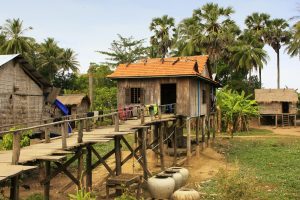Microfinance claims to have a “double bottom line.” Lending to poor populations in developing countries needs to be profitable to be sustainable, while social impact in terms of achieving “financial inclusion” is also demanded by those who invest in the industry.
The truth, for microfinance as for any other industry, is that there is only one bottom line: the financial one. A “double bottom line” is a misleading metaphor.
There’s a growing body of academic research about microfinance in Cambodia which makes that conclusion hard to escape. The latest addition, funded by the National University of Singapore and published in June, was carried out by W. Nathan Green, Theavy Chhom, Reach Mony, and Jennifer Estes. Their key argument is that financial performance indicators used by the microfinance industry in Cambodia, especially portfolio quality, “hide and exacerbate” the ways that borrowers juggle debt between formal and informal lenders.
The researchers carried out 56 interviews with microfinance leaders, state regulators, market consultants, and international investors in Phnom Penh, as well as interviews with 16 bank and microfinance branch staff, 18 informal lenders, and 11 local authorities in Battambang province. The interviews took place in 2021 and 2022.
Based on the idea of a double bottom line, international microfinance investors often use portfolio quality as a proxy for social impact. The real bottom line is that high rates of non-performing loans (NPLs) raise the future cost for Cambodian banks and microfinance institutions to secure their funding. If their NPLs exceed the levels specified in loan covenants, the loans can be clawed back.
So, as in any other kind of lending, NPLs have to be kept down by any possible means. The specific problem in Cambodia is that the country has the world’s largest proportion of microfinance borrowers relative to its population, with average loan sizes well in excess of per capita annual income. There were 3.06 million active microloans in Cambodia in 2022, in a country with only 3.6 million households. The majority of the loans are secured by land-based collateral.
One of microfinance’s leading claims is that it can rescue people from informal borrowing. That’s not happening in Cambodia, where one in three adults borrow from both formal and informal sources. The research found that 32 percent of interviewed households with a formal loan were using informal lenders to be able to repay formal loans.
Some are borrowing from daily lenders and pawnshops charging interest rates of between 20 percent and 30 percent per month. “So long as repayment rates are considered an indicator of success, then the risks associated with juggling debt are likely to increase,” the research finds.
Cambodia’s high repayment rates, the research finds, depend on “coercive peer pressure, social shaming and various forms of gendered exploitation.” The costs of a good repayment record very often include malnutrition, forced migration, child labor, debt bondage, and land dispossession, the research finds. One family told of their aging mother who sold land before she died to avoid having debt hanging over her in the afterlife, which she believed would cause her to be reborn at a lower status.
Throughout the 2010s, between 25 percent and 50 percent of all Cambodian microfinance borrowers had to make monthly loan payments which exceeded their incomes. Lenders largely fail to measure the impact of their activity. Eight of the 10 Cambodian banks and microfinance institutions questioned told the researchers that they had no internal monitoring system to assess impact. The Cambodia Microfinance Association likewise has not carried out any systematic impact study.
Economists often analyze microfinance in isolation from its national contexts. Cambodian institutions, for a range of historical reasons, are in general weaker than in many developing countries. Guidelines to curb excessive lending are therefore ineffective. “Some lenders violate the industry’s own code of conduct lending guidelines,” Green told The Diplomat. But information on which lenders are violating the industry’s code of conduct on lending is not made public.
The capacity of Cambodia’s national bank to regulate the code of conduct is “quite limited” as there is no legal mechanism to enforce compliance, Green said. “I believe making consumer protection guidelines adopted by the industry legally mandatory would be one way to improve regulatory capacity,” he added.
Neighboring countries have better institutional capacity for delivering responsible microfinance, Green said. He pointed to Thailand’s state-run Bank of Agriculture and Agricultural Cooperatives (BAAC), which supplies the majority of loans to farmers in the country. The BAAC is not-for-profit, and so charges lower interest rates, while providing other social services to farmers through its branch network. In Vietnam, the state also plays a larger role in providing microfinance services than in Cambodia, Green said.
Overall, performance-driven lending practices are a problem that extends well beyond Cambodia. The microfinance industry “claims that it successfully helps to alleviate poverty, even as it accumulates profits by appropriating wealth from poor and low-income households across the global South,” the research concludes.

































